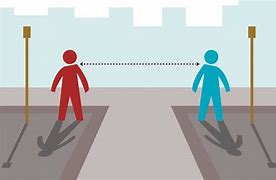The MIT researchers noted that the six-foot rule, observed globally, is based on an outdated understanding of how COVID-19 spreads in closed spaces.
They advised that a better way of controlling indoor exposure is for calculations to be based on individual’s variables for the space.
However, reacting to the study, Assistant Director, Medical Laboratory, Federal Medical Centre, Ebute Meta, Victor Ojedapo, said the six feet rule, to a great extent, helped to curb the spread of COVID-19, especially in Nigeria.
He noted that changing dynamics of the virus could have led to the latest findings, adding, “This doesn’t mean that the six feet rule is ineffective. When it comes to science, there is always a need for periodic reviews.”
Ojedapo noted that some countries are in their third lockdown phase because they relaxed social distancing rules. He said a typical example is India, which, despite producing the AstraZeneca vaccine against COVID-19, is seriously under the stronghold of the virus.
“India developed the AstraZeneca vaccine, but now, the country can’t save its people. Corpses are being cremated in large numbers,” he said.
Since the outbreak of COVID-19 in December 2019, the Centres for Disease Control and Prevention, recommendation for social distancing for both indoor and outdoor, was six feet, while the UK, specified 2 meters distancing.
In most parts of Europe, the recommended figure is one meter, which is also the minimum required distance advised by the World Health Organization.
The researchers, however, noted that in as much as the distancing rules are easy to remember, and are purported to suit any situation, their findings showed that they may not be that effective.
According to two of the researchers, who are professors in Applied Mathematics, Martin Bazant and John Bush, a more effective way to control indoor exposure is through individual calculations based on variables for the space.
The researchers said they developed a formula to estimate how long it would take for a person to hit dangerous levels of exposure from one infected person entering a room, and noted that in some cases, the exposure level might be the same at six feet and at 60 feet.
“The distancing isn’t helping you that much, and it’s also giving you a false sense of security because you’re as safe at six feet as you are at 60 feet, if you are indoors. Everyone in that space is roughly at the same risk, actually,” Bazant explained.
The researchers noted that the calculation is a more sophisticated version of the traffic light system previously proposed by MIT.
They further explained that the calculation takes into cognisance the number of people in the room, the size of the space, what they are doing, whether masks are being worn, and what kind of ventilation is in place.
“Using this calculation, it could be that the level of exposure is high in some spaces even if people are more than 6 feet away. It could also be lower than expected,” they added.
According to experts, scientific understanding of how COVID-19 moves in the air has challenged earlier assumptions about how best to adapt, to minimize its spread.
They noted that at the beginning of the pandemic, the general belief was that the virus can be spread through heavier droplets ejected during exhalation, sneezing, or speaking.
They, however, said evidence later showed that the virus floats around on lighter aerosol droplets that can stay suspended in the air and travel much farther than initially imagined.
Further speaking on the study, the MIT researchers said in their calculation, they took into account the effect of having people in the room, their behaviour, and how long the virus can stay suspended in the air.
They explained that the particles would slowly drift to the ground in a calm environment; but that where people are talking, eating, singing and sneezing, the droplets can be suspended in the airflow and mix in the room for much longer.
They, however, said the effect can be counteracted by ventilation or filtration to get the virus particles out of circulation in the room.
“For example, if an infected person walks into a classroom hosting 25 people, who are not wearing masks and are all speaking, everyone would be at risk from the coronavirus within 36 minutes. It doesn’t matter if they follow the 6-foot rule.
“By contrast, if all 25 people in that room were wearing a mask, the air would be safe to breathe for 20 hours.
“If they were all singing without a mask, they would be at risk from the virus within three minutes,” the researchers explained.
Based on reports, public health bodies have started to acknowledge that the six-foot rule might not be applicable.
The CDC has already advised that the 6-foot rule be brought down to three feet in K-12 schools.
The agency in a report published online by NPR News in March, also updated social distancing guidelines for children in summer camps to three feet, except when eating or drinking.
It further suggested that disinfection of surfaces might not be necessary in public spaces, and called for an end to what it referred to as “hygiene theatre”.
The revision, according to NPR News, was spurred by some new research, including a study published on March 10, in Clinical Infectious Diseases, a peer-reviewed journal.
According to Bazant, rules dictating social distancing outdoors are “kind of crazy”, because the infected air “would be swept away”, making the rules irrelevant.
He noted that unless the space outdoors is crowded, he would feel comfortable being as close as three feet, even without masks.
Experts advised that when it is possible to stay more than six feet away from people, the need to wear a face mask might not be necessary.
However, Ojedapo advised that despite the recent finding, Nigerians should still adhere to non-pharmaceutical guidelines specified by relevant health agencies to curb the spread of COVID-19.
He said, “If you don’t have any business outside, stay at home, and don’t entertain too many visitors. The rule remains to avoid crowded places.
“The virus is still out there. If you look around, people are still coughing and sneezing, and won’t go for testing. Most people have been exposed to the virus and are yet to get tested. Most people don’t mask up again. It is better to stay safe.”
source: Punch

 A study states that observing social distancing by staying six feet apart indoors can’t effectively prevent the spread of COVID-19. Findings from the research shows that other factors, like the number of people in a space, whether they use face masks, what they are doing, and the level of ventilation, are much more important.
A study states that observing social distancing by staying six feet apart indoors can’t effectively prevent the spread of COVID-19. Findings from the research shows that other factors, like the number of people in a space, whether they use face masks, what they are doing, and the level of ventilation, are much more important.







